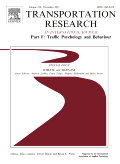
During risky conditions, Powered-Two-Wheeler (PTW) drivers often alter their behavior from a regular driving pattern to an irregular chain of driving actions by braking, changing the throttle pressure, maneuvering and so on, or combinations of the above. However, both the actual and perceived thresholds of regular and irregular driving behavior differ among PTW drivers. A simple and flexible methodology is proposed in order to define PTW driving profiles by distinguishing between regular and irregular PTW driving behaviors using high resolution naturalistic data. “Irregularities” in driving behavior are consistently expressed as outlying values in the dataset of driving parameters. The detected irregularities are those that diverge from the centroid of the jointly considered driving parameters. These irregularities may be considered to define critical driving situations (incidents) that are further associated to typical driving events. Results indicate that the joint consideration of variables which are directly connected to the mechanical characteristics of PTW, such as front and rear brake activation, wheel speed, throttle and steering, are adequate to distinguish the regular from irregular PTW driving behavior.
| ID | pj87 |
| Manuscript | |
| DOI | |
| Tags | motorcyclists, naturalistic driving, statistical modelling |







